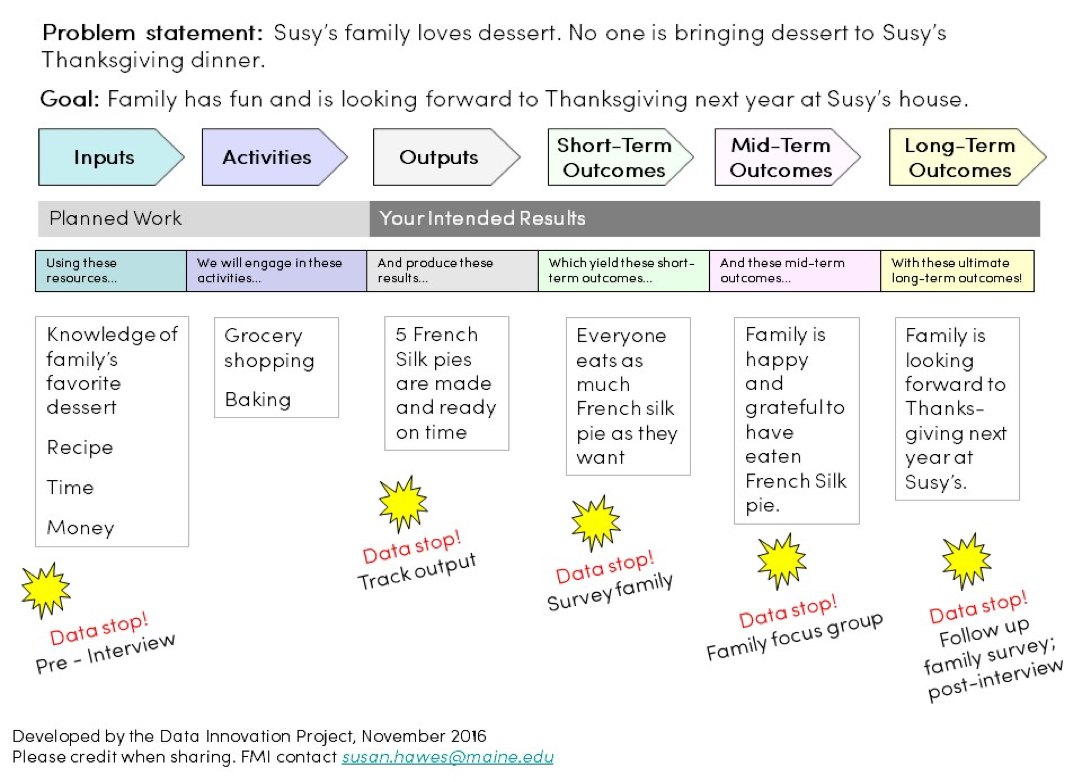Hi! I am Susy Hawes from the University of Southern Maine’s Data Innovation Project (DIP). Part of the DIP’s work is providing free technical assistance to local nonprofits around a data issue. Even though the majority of nonprofits do not believe our time together should be spent around a logic model (because we have been told they are scary boring, or useless), we find most answers to any data issue can be found somewhere in the living and evolving document that is a logic model. Rather than dive right into yet another logic model template, we frame the conversation around a set of questions (that happen to line up quite nicely with the template we use). We get curious about what they are working toward in their day to day work, challenge how different activities and programs line up with their mission, and ask them to describe how they envision their organization contributing to a larger, population level change. Then, we tell them they just developed their logic model!
Lesson Learned: Tap into the freedom of plausible attribution. Often, organizations we speak with think they alone are responsible for creating those population level changes. We tell them that if their program model is based in a body of literature and evidence showing proven success then it is highly lausible they will meet those long-term outcomes, with the help of a community of initiatives working toward the same goals. At this point, there is quite often an audible sigh of relief and big smiles. Emphasizing that organizations on their own are not solely responsible for the long term outcome or population level result has a freeing effect. Too often, small organizations with limited evaluation capacity are asked to prove how they are contributing to these population level changes. Providing them with language around plausible attribution they can then use with their boards and funders is extremely helpful.
Hot Tip: Get creative! We developed a “logic model on pie” to explain the concept of a logic model in a simple, accessible and non-intimidating way. Creativity and humor can go a long way. Give it a try!
Do you have questions, concerns, kudos, or content to extend this aea365 contribution? Please add them in the comments section for this post on the aea365 webpage so that we may enrich our community of practice. Would you like to submit an aea365 Tip? Please send a note of interest to aea365@eval.org . aea365 is sponsored by the American Evaluation Association and provides a Tip-a-Day by and for evaluators.


So, what is the language around plausible attribution? We run against this all the time.
Hi Ione,
We talk with organizations about how hard it can be to capture the net impact of their work (especially with a small evaluation budget) because most often there are other initiatives working toward the same goals. We tell them that if their program model is based in a body of literature and evidence showing proven success (e.g. if your youth-engagement program was developed based on strategies that have an evidence-base of success) then it is highly plausible they will meet those long-term outcomes. Hope that helps!
Susy
We have a logic model on cake which also shows why you can’t just add up indicators at different levels (the quality of eggs influences the cake but you can’t judge the cake by the eggs alone. (I sadly can’t upload the model here but happy to share).